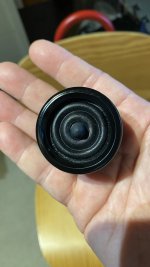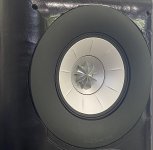I've posted a small study comparing High, Medium and Low Frequency drivers in a variety of cabinets.
It's on another forum that allows me to edit/amend as more data becomes available.
First up, some pretty colors:
SPEAKER A:


SPEAKER B:


Now, if you're not sure of how what these colors/shapes mean, then this directivity study is for you!
It's aimed at bringing you along the journey of speaker designs which have with smooth frequency responses in many directions.
If you are familiar with seeing a single on-axis (or a few off-axis ) measurements for loudspeakers, please have a look at this study to observe how off-axis measurements varying over a larger span eg. up to 360° horizontally and vertically may add value to your designs, and how the use of non-normalized polar maps may assist.
My study incorporates-
1.High Frequency devices includes dome tweeters, ring radiators, ribbon tweeters, compression drivers, in cabinets with and without round-overs, with or without waveguides/horns, or even without cabinets (nude).
Start at the top for a background/explanation
Jump straight to posts for non-normalised polar maps (horizontal 0 to +/- 90 ° minimum; 0 to +/- 180 ° horizontally and vertically where/when available):
All drivers highlighted in bold type are by fellow DIYers who kindly offered their data for our perusal / interpretation.
A model of a theoretical 3/4" flat piston tweeter on a 5 1/8" wide baffle with large 1.5" round-over
SB Acoustics SB19ST-C00-04 a 3/4" soft dome tweeter on a 5 1/8" wide baffle with 1" round-over
SB Acoustics SB29SDAC on a 8" wide baffle (coming soon)
Scan-Speak D2604/8330-00: 1" soft dome on a 8.5" wide cabinet, offset 1/2" from center line
Scan-Speak R2604/8330-00: 1" ring radiator in same cabinet, again offset 1/2" from center line
Fountek NeoCD3.0 a 8x60mm ribbon tweeter on a 8.75" wide cabinet with 10mm round-over courtesy @DcibeL
Fountek NeoCD3.0 on a 11.5" wide cabinet with 3/4" round-over courtesy Curt Campbell and @jholtz
Fountek NeoCD3.5H a ribbon tweeter & integrated horn on a 8.5" wide cabinet with 3/4" round-over, courtesy Göran @gornir
Fountek NeoCD3.5H nude (not mounted on any cabinet), courtesy @Juhazi
B&W HF00963 in tapered tube hard dome tweeter in a minimal baffle/tapered cylinder, courtesy @PKAudio
Tymphany DFM-2335R00-08 attached to a SB Acoustics H225 and H250 constant directivity horns, both nude
Tweeter of SICA 5-5-C-15-CP coaxial driver, mounted in 7" circular frame with 1/2" round-over, courtesy @vineethkumar01
Tweeter for SB Acoustics SB17CAC / SB17NBAC coaxial prototype courtesy @5th element
Tymphany XT25BG60-04 in Visaton WG148R waveguide, mounted on 11" wide baffle with 1.5" round-over
Various tweeters in courtesy @augerpro's waveguides mounted in real cabinets, with or without round-overs (including SB26CDC in 6.5" elliptical waveguide, Peerless OT19NC00-04 in 8" elliptical waveguide, horizontal measurements), Donate!
SB Acoustics SB26ADC in a customized 8" waveguide for 60° beamwidth from 1K to 12KHz. courtesy @fluid
tweeter from KEF R series (non-META) coaxial, mounted in a cabinet with 1.5" round-overs
tweeter from KEF Blade Meta/Reference Meta, mounted in cabinet with 1.5" round-overs vs no round-over (awaiting cabinets)
2. Medium Frequency devices includes cones and domes, typically covering 3-400Hz to 3-4KHz
B&W 5" FST midrange in 8.75" wide cabinet with r10mm round-over, courtesy @DcibeL
Larger 6" FST midrange in 9.5" wide cabinet and 8.5" spheroidal cabinet
previous generation (Kevlar) 6" FST midrange in the same 8.5" spherical cabinet
Volt VM752 3" dome midrange in 14.5" wide cabinet, offset 1 11/16" from center, courtesy @mbrennwa
Faital 4FE42 4" cone midrange in a 6" spheroidal cabinet
Purifi 5" and 6.5" drivers on same width baffle (completed, awaiting publication)
Purifi 6.5" aluminium vs fibre cone (completed, awaiting publication)
3. Low Frequency devices includes woofers and/or subwoofers, typically covering 3-400Hz and below:
KEF LS60 's dual 5.25" woofers, side firing, in dual opposed configuration, rear ported courtesy @bikinpunk
KEF Blade 2 Meta's quad 6.5" woofers, in dual opposed configuration, 2 on each side panel, with rear firing ports courtesy @bikinpunk
KEF R11 Meta, quad 6.5" woofers, all 4 on front panel, with rear firing ports courtesy ASR (coming soon)
Thanks again to all those involved who kindly supplied their measurements.
If you find anything that you feel is a misrepresentation of your data, please let me know.
All constructive comments welcome, as well as suggestions for better readability. It's a lot of graphs, I know.
PS. If a link is currently unavailable; then it is currently being updated/edited. Try again in 24 hours. Thanks for your patience.
It's on another forum that allows me to edit/amend as more data becomes available.
First up, some pretty colors:
SPEAKER A:
SPEAKER B:
Now, if you're not sure of how what these colors/shapes mean, then this directivity study is for you!
It's aimed at bringing you along the journey of speaker designs which have with smooth frequency responses in many directions.
If you are familiar with seeing a single on-axis (or a few off-axis ) measurements for loudspeakers, please have a look at this study to observe how off-axis measurements varying over a larger span eg. up to 360° horizontally and vertically may add value to your designs, and how the use of non-normalized polar maps may assist.
My study incorporates-
1.High Frequency devices includes dome tweeters, ring radiators, ribbon tweeters, compression drivers, in cabinets with and without round-overs, with or without waveguides/horns, or even without cabinets (nude).
Start at the top for a background/explanation
Jump straight to posts for non-normalised polar maps (horizontal 0 to +/- 90 ° minimum; 0 to +/- 180 ° horizontally and vertically where/when available):
All drivers highlighted in bold type are by fellow DIYers who kindly offered their data for our perusal / interpretation.
A model of a theoretical 3/4" flat piston tweeter on a 5 1/8" wide baffle with large 1.5" round-over
SB Acoustics SB19ST-C00-04 a 3/4" soft dome tweeter on a 5 1/8" wide baffle with 1" round-over
SB Acoustics SB29SDAC on a 8" wide baffle (coming soon)
Scan-Speak D2604/8330-00: 1" soft dome on a 8.5" wide cabinet, offset 1/2" from center line
Scan-Speak R2604/8330-00: 1" ring radiator in same cabinet, again offset 1/2" from center line
Fountek NeoCD3.0 a 8x60mm ribbon tweeter on a 8.75" wide cabinet with 10mm round-over courtesy @DcibeL
Fountek NeoCD3.0 on a 11.5" wide cabinet with 3/4" round-over courtesy Curt Campbell and @jholtz
Fountek NeoCD3.5H a ribbon tweeter & integrated horn on a 8.5" wide cabinet with 3/4" round-over, courtesy Göran @gornir
Fountek NeoCD3.5H nude (not mounted on any cabinet), courtesy @Juhazi
B&W HF00963 in tapered tube hard dome tweeter in a minimal baffle/tapered cylinder, courtesy @PKAudio
Tymphany DFM-2335R00-08 attached to a SB Acoustics H225 and H250 constant directivity horns, both nude
Tweeter of SICA 5-5-C-15-CP coaxial driver, mounted in 7" circular frame with 1/2" round-over, courtesy @vineethkumar01
Tweeter for SB Acoustics SB17CAC / SB17NBAC coaxial prototype courtesy @5th element
Tymphany XT25BG60-04 in Visaton WG148R waveguide, mounted on 11" wide baffle with 1.5" round-over
Various tweeters in courtesy @augerpro's waveguides mounted in real cabinets, with or without round-overs (including SB26CDC in 6.5" elliptical waveguide, Peerless OT19NC00-04 in 8" elliptical waveguide, horizontal measurements), Donate!
SB Acoustics SB26ADC in a customized 8" waveguide for 60° beamwidth from 1K to 12KHz. courtesy @fluid
tweeter from KEF R series (non-META) coaxial, mounted in a cabinet with 1.5" round-overs
tweeter from KEF Blade Meta/Reference Meta, mounted in cabinet with 1.5" round-overs vs no round-over (awaiting cabinets)
2. Medium Frequency devices includes cones and domes, typically covering 3-400Hz to 3-4KHz
B&W 5" FST midrange in 8.75" wide cabinet with r10mm round-over, courtesy @DcibeL
Larger 6" FST midrange in 9.5" wide cabinet and 8.5" spheroidal cabinet
previous generation (Kevlar) 6" FST midrange in the same 8.5" spherical cabinet
Volt VM752 3" dome midrange in 14.5" wide cabinet, offset 1 11/16" from center, courtesy @mbrennwa
Faital 4FE42 4" cone midrange in a 6" spheroidal cabinet
Purifi 5" and 6.5" drivers on same width baffle (completed, awaiting publication)
Purifi 6.5" aluminium vs fibre cone (completed, awaiting publication)
3. Low Frequency devices includes woofers and/or subwoofers, typically covering 3-400Hz and below:
KEF LS60 's dual 5.25" woofers, side firing, in dual opposed configuration, rear ported courtesy @bikinpunk
KEF Blade 2 Meta's quad 6.5" woofers, in dual opposed configuration, 2 on each side panel, with rear firing ports courtesy @bikinpunk
KEF R11 Meta, quad 6.5" woofers, all 4 on front panel, with rear firing ports courtesy ASR (coming soon)
Thanks again to all those involved who kindly supplied their measurements.
If you find anything that you feel is a misrepresentation of your data, please let me know.
All constructive comments welcome, as well as suggestions for better readability. It's a lot of graphs, I know.
PS. If a link is currently unavailable; then it is currently being updated/edited. Try again in 24 hours. Thanks for your patience.
Last edited:
I see what you are saying @Boden. There are MANY graphs. I start the pace slowly so as not lose the reader, but I wonder whether it becomes too repetitive quickly.
I also agree with you regarding normalized graphs appearing easier on the eye. For some time I had been working this way too. However, the actual SPL is a better representation of what is going on. eg. system sensitivity. Also an on-axis response is NOT always perfectly flat (and it's doesn't need to be perfectly, as the directivity study shows.
If you start at the Low Frequency directivity study with the side mounted woofers, I try and show the advantages of viewing the non-normalized directivity map. It shows the absolute SPL in all angle. It is more realistic than one where everything is compared to the on-axis.
This is what @gedlee and others have been championing for a long time. I concur!
I also agree with you regarding normalized graphs appearing easier on the eye. For some time I had been working this way too. However, the actual SPL is a better representation of what is going on. eg. system sensitivity. Also an on-axis response is NOT always perfectly flat (and it's doesn't need to be perfectly, as the directivity study shows.
If you start at the Low Frequency directivity study with the side mounted woofers, I try and show the advantages of viewing the non-normalized directivity map. It shows the absolute SPL in all angle. It is more realistic than one where everything is compared to the on-axis.
This is what @gedlee and others have been championing for a long time. I concur!
Last edited:
Sorry, I don't have the authority to release FRD or TXT files to these drivers.
Just added:
Faital Pro's new (for 2023) 4FE42 4" cone pure midrange, with copper sleeve in the neo motor
Reference:
https://faitalpro.com/en/products/LF_Loudspeakers/product_details/index.php?id=401005105
I mounted it in a 6" spheroidal cabinet, and here are some basic measurements, with a 5ms window (200Hz resolution)

Distortion measured at 0.5m...

This 8 ohm driver has healthy sensitivity of 94dB/2.83V sensitivity, and still 89dB after baffle step compensation. It can be used from 300Hz to 3KHz LR4, where the distortion is class leading.
Directivity studying pending approval: Faital Pro 4FE42
Just added:
Faital Pro's new (for 2023) 4FE42 4" cone pure midrange, with copper sleeve in the neo motor
Reference:
https://faitalpro.com/en/products/LF_Loudspeakers/product_details/index.php?id=401005105
I mounted it in a 6" spheroidal cabinet, and here are some basic measurements, with a 5ms window (200Hz resolution)
Distortion measured at 0.5m...
This 8 ohm driver has healthy sensitivity of 94dB/2.83V sensitivity, and still 89dB after baffle step compensation. It can be used from 300Hz to 3KHz LR4, where the distortion is class leading.
Directivity studying pending approval: Faital Pro 4FE42
Last edited:
Not exactly on topic, but an old nice source of directivity measurements of loudspeakers. Presentations do vary, sorry.
https://3d3a.princeton.edu/loudspeaker-directivity-ongoing-experimental-survey
https://3d3a.princeton.edu/loudspeaker-directivity-ongoing-experimental-survey
Not just complicated, normalized is the only proper way to see what's going on in terms of directivity.Is it it lot to ask to show us additional normalized on and off axis curves? It would then - at least for me- be much clearer to interpret the relationship between the on- and off axis curves. This now is visually quite complicated.
Non-normalized is only useful to see why the directivity at a certain frequency has a certain behavior.
But looking at non-normalized graphs for directivity purposes is totally useless.
Like you said, some frequency responses are FAR to complicated to understand what's going on.
Which very quickly leads to wrong interpretation and conclusions (and therefor misinformation)
You might as well just not post them for these purposes.
That's not an opinion btw. Sorry.
Non-normalized is only useful to see why the directivity at a certain frequency has a certain behavior.
My point exactly. Thank you. If you want to see the effect of a round-over, a facet, a flat rectangular baffle, a spherical baffle, in combination
with what a particular driver does, this is advantage of non-normalized.
When someone says "Well I designed my speakers with DSP and it perfectly flat, but it sounded terrible" now you may see why a wiggly
on-axis response that is NOT totally flat might be preferable. eg. optimizing for power response.
If anyone just wants to compare directivity, you can straight to original source.
Spinorama.org is has it all, and more. No need view a remixed version here.
eg. KEF R11 Meta- out of the box:

Directivity, normalised: horizontal:
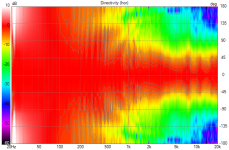
Vertical:
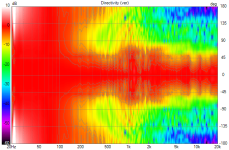
EQualised for flat listening window and downward in-room response:

Directivity: normalised, horizontal:
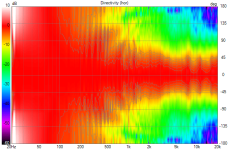
Vertical:
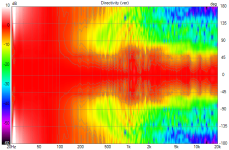
ie. there is NO CHANGE to a heat map in a NORMALISED VIEW
Here is the (non-normalised ie. actual SPL) heat map-
Horizontal
Before EQ:
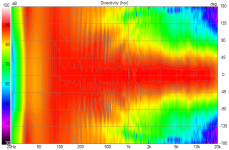
After EQ:
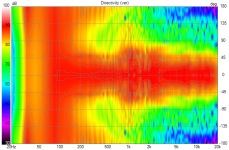
Vertical:
Before EQ:
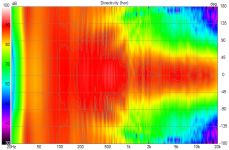
After EQ:
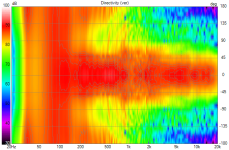
Normalised and non-normalised views each have their uses.
Just because it looks more complicated doesn't mean it's something to avoid looking at.
Directivity, normalised: horizontal:

Vertical:

EQualised for flat listening window and downward in-room response:
Directivity: normalised, horizontal:

Vertical:

ie. there is NO CHANGE to a heat map in a NORMALISED VIEW
Here is the (non-normalised ie. actual SPL) heat map-
Horizontal
Before EQ:

After EQ:

Vertical:
Before EQ:

After EQ:

Normalised and non-normalised views each have their uses.
Just because it looks more complicated doesn't mean it's something to avoid looking at.
Last edited:
A great example of brute force equalization being a bad ideaEQualised for flat listening window and downward in-room response:
- Home
- Loudspeakers
- Multi-Way
- Directivity study- polar maps of HF, MF and LF drivers in cabinets

